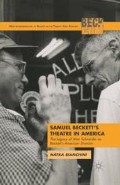Abstract
Waiting for Godot, Beckett’s first published play, had not one but two different American premieres, in two separate productions. The first, directed by Schneider, opened at the Coconut Grove Playhouse in Miami, Florida, and closed after two weeks, a critical and commercial flop. The second, which was not directed by Schneider, opened on Broadway a few months later and enjoyed a modest run of about two months. It was the first and only time that Schneider was not at the helm of a major Beckett premiere in this country.1
Access this chapter
Tax calculation will be finalised at checkout
Purchases are for personal use only
Preview
Unable to display preview. Download preview PDF.
Notes
Alan Schneider Entrances: An American Director’s Journey (New York: Proscenium, 1987), 183–186.
Craig et al., eds., The Letters of Samuel Beckett, 1941–1956 (Cambridge: Cambridge University Press, 2011), 413.
Myerberg originally wanted Sir Peter Hall, director of the British premiere, to direct the American production, but he was unavailable (Craig, 570). See also James Knowlson, Damned to Fame, The Life of Samuel Beckett (New York: Simon & Schuster, 1996), 375.
Arnold Aronson, American Avant-Garde Theatre: A History (London: Routledge, 2000), 42–44. The size of off-Broadway houses has since been increased to a maximum of 499, with a minimum of 100.
David A. Crespy, Richard Barr: The Playwright’s Producer (Carbondale: Southern Illinois University Press, 2013), 79.
Joseph W. Zeigler, Regional Theatre: The Revolutionary Stage, with a forward by Alan Schneider (Minneapolis: University of Minnesota Press, 1973), 17–31.
Beckett to Schneider, December 14, 1955, Maurice Harmon ed., No Author Better Served: The Correspondence of Samuel Beckett and Alan Schneider (Cambridge: Harvard University Press, 1998), 2–5. The majority of Beckett’s notes to Hall concern details of pronunciation, pacing, pauses, and emphasis.
See David Bradby, Waiting for Godot, Plays in Production (Cambridge: Cambridge University Press, 2001), 80. Bradby offers an insightful reading as to why both English and American audiences were hesitant about the play at first, which resulted in similar problems in each premiere.
Les Essif Empty Figure on an Empty Stage (Bloomington: Indiana University Press, 2001), 27.
Una Chaudhuri, Staging Place: The Geography of Modern Drama (Ann Arbor: University of Michigan Press, 1995), 23.
See Ruby Cohn, “Animateurs de Beckett,” in Samuel Beckett Revue d ’Esth é tique, ed. Pierre Chabert (Paris: Jean-Michel Place, 1990), 192.
Samuel Beckett. Complete Dramatic Works (London: Faber and Faber, 1990), 50.
Dougald McMillan and James Knowlson, eds., The Theatrical Notebooks of Samuel Beckett: Volume I: Waiting for Godot (New York, Grove Press, 1994), xiv.
John Lahr, Notes on a Cowardly Lion (New York: Alfred A. Knopf, 1969), 263–264.
Director Herbert Blau encountered similar skepticism when he first worked on the play with the Actor’s Workshop around the same time. He even raised with Beckett his concern that the play was somehow “un-American”: see Blau , As If (Ann Arbor: University of Michigan Press, 2011), 220–221.
John Bell, “American Drama in the Postwar Period,” in Concise Companion to Postwar American Literature and Culture, ed. Josephine G. Hendin (Malden: Blackwell, 2004), 110–113.
Anna McMullan, “Samuel Beckett as director: the art of mastering failure,” in The Cambridge Companion to Beckett, ed. John Pilling (Cambridge: Cambridge University Press, 1994), 196–208.
See Loren Glass, Counter-Culture Colophon: Grove Press, The Evergreen Review, and the Incorporation of the Avant-Garde (Stanford: Stanford University Press, 2013), 69–70.
David Brady Waiting for Godot, Plays in Production (Cambridge: Cambridge Un iversity Press, 2001), 96–105.
See a lso S. E. Gontarski, “Beckett’s Reception in the USA,” in The International Reception of Samuel Beckett, ed. Mark Nixon and Matthew Feldman (London: Continuum, 2009), 12–13.
Martin Esslin The Theatre of the Absurd, 3rd ed. (New York: Vintage Books, 2004 [1961]), 19–28.
See Herbert Blau, The Impossible Theatre (New York: Macmillan, 1964), 236, and Sails of the Herring Fleet: Essays on Beckett (Ann Arbor: University of Michigan Press, 2000), 37.
Copyright information
© 2015 Natka Bianchini
About this chapter
Cite this chapter
Bianchini, N. (2015). The Laugh Sensation of Two Continents!. In: Samuel Beckett’s Theatre in America. New Interpretations of Beckett in the Twenty-First Century. Palgrave Macmillan, New York. https://doi.org/10.1057/9781137439864_2
Download citation
DOI: https://doi.org/10.1057/9781137439864_2
Publisher Name: Palgrave Macmillan, New York
Print ISBN: 978-1-349-68395-6
Online ISBN: 978-1-137-43986-4
eBook Packages: Palgrave Theatre & Performance CollectionLiterature, Cultural and Media Studies (R0)

